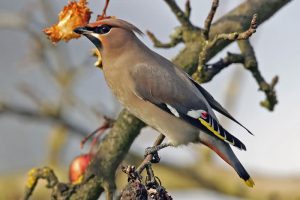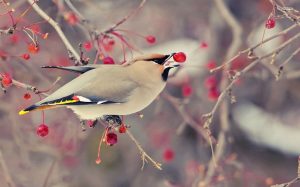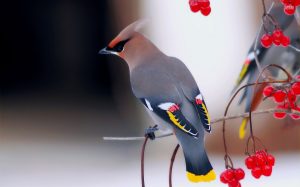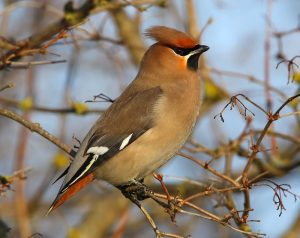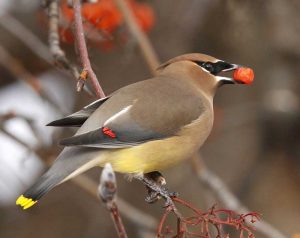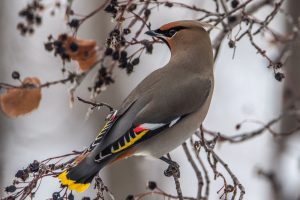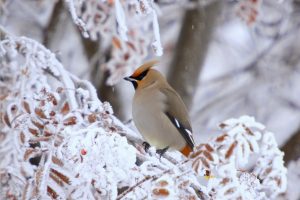Bohemian Waxwing
The bohemian waxwing is a passerine bird. Due to its waxy feather and wandering nature, the bird has been named as such.
Scientific Classification
| Kingdom | Animalia |
| Phylum | Chordata |
| Class | Aves |
| Order | Passeriformes |
| Family | Bombycillidae |
| Genus | Bombycilla |
| Scientific Name | Bombycilla garrulus |
Quick Information
| Description | Size: 7.4-9.0 in (18.7-22.8 cm) Wingspan: 11.8-14.1 in (29.9-35.8 cm) Weight: 1.64-2.43 oz (46.4-68.8 g) Color: Gray body, chestnut-colored face, yellow-banded tail-tips, secondary feathers have red waxy tips. |
| Subspecies and Distribution | 1. B. g. garrulus northern Sweden(east side to Ural Moutain) to northern Europe 2. B. g. centralasiae Ural Mountains, throughout Asia 3. B. g. pallidiceps Northwestern North America |
| Habitat | Coniferous forests with spruce, mountain-ashes or rowans, and wet woodlands |
| Sound & Calls | High-pitched ‘srrr’. Mating and breeding calls are of high frequency while juveniles call for their parents in a low voice |
| Lifespan | 5-13 years |
| Diet | Mostly fruits, juniper, ash, and holly berries |
| Adaptations | The beak of the bird is able to have an exceptionally huge gape so that it can pluck fruits of all sizes. Even those fruits, that can’t be plucked due to their odd placements, the bird can take out a considerable portion from them. |
| Predators | Prairie falcons, Eurasian sparrowhawks, rough-legged hawks, and merlins |
| IUCN Conservation Status | Least Concern |
Behavior
- The bird stays in flocks during their migration and foraging.
- By flapping its wings, the bohemian waxwing often hovers from one perch to another, rarely walking on the ground.
- It takes a bath in gathered water due to rain and scratches its head by keeping its foot on its extended wings.
- Male waxwings are protective about their mates and often threaten other males who are trying to snatch their mates.
Mating and Reproduction
Winter is the season when two potential mates meet each other and through a brief period of courtship, they mate from March to April or from May to June. The courtship session includes hopping and feeding. Perched at top, facing each other, the couple starts to hop towards each other until they touch each other’s beak with an exchange of food or other objects. After successful mating, the female lays around 4-6 glossy black dotted eggs with light blue and gray shades. The incubation period is usually 13-14 days and is done by the female waxwing.
Life-cycle
The hatchlings are incapable to move on their own. They are fed insects or fruits by both of their parents. It takes 14-16 days for them to fledge.
Interesting Facts
- The female waxwing prefers males with more waxy wings.
- The Swedish botanist, Carl Linnaeus, rightly called the father of modern taxonomy described the species for the first time in 1758 as Lanius Garrulus but later in 1808, ornithologist Louis Jean Pierre Vieillot moved the species to the genus Bombycilla.
- For birdwatchers, this is a popular species to look for.
References
- https://www.allaboutbirds.org/guide/Bohemian_Waxwing/id
- https://www.audubon.org/field-guide/bird/bohemian-waxwing
- https://www.oiseaux-birds.com/card-bohemian-waxwing.html
- http://www.oiseaux-birds.com/card-bohemian-waxwing.html
Published on August 2nd 2019 by Sahana Kanjilal under Coniferous Forest Animals.
Article was last reviewed on 17th July 2023.


